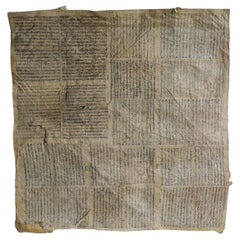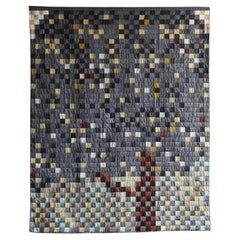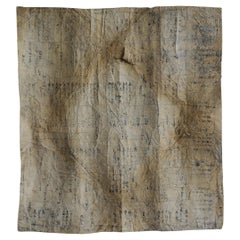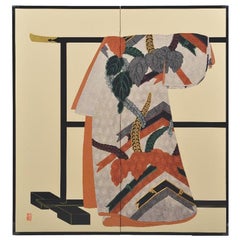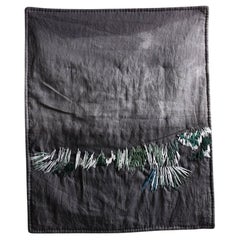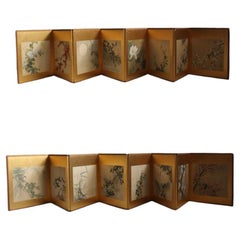Japan - Paintings and Screens
to
218
1,087
447
169
49
24
1
27
58
84
49
36
12
11
1
2
9
2
9
6
2
121
97
91
58
57
215
204
201
3
218
215
216
29
2
1
Item Ships From: Japan
Japanese Antiques , Old Wrapping Paper , Tapestries , Wabi-Sabi
Located in Katori-Shi, 12
We present to you a precious old wrapping paper from the Taisho period.
This washi paper was used to wrap important items. It was made by overlapping multiple ledgers, and is chara...
Category
Early 20th Century Japanese Taisho Japan - Paintings and Screens
Materials
Paper
Tree by Blue Tip Atelier
Located in Sammu-shi, Chiba
Title : Tree
Japan / 2021s
Size : W 1100 H 1400 mm
This quilt is a traditional technique called nine patches,
which skillfully uses the shades of cloth to create a mosaic effec...
Category
2010s Japanese Modern Japan - Paintings and Screens
Materials
Linen
$3,000
Japanese Antiques , Tapestries , Wabi-Sabi
Located in Katori-Shi, 12
We present to you a precious old wrapping paper from the Taisho period.
This washi paper was used to wrap important items. It was made by overlapping multiple ledgers, and is chara...
Category
Early 20th Century Japanese Taisho Japan - Paintings and Screens
Materials
Paper
Japanese Contemporary Orange Black Silk Brocade Two-Panel Folding Screen, 3
Located in Takarazuka, JP
Extraordinary Japanese contemporary two panel "byobu" or folding screen featuring genryoku style handcrafted raised silk and brocade kimono in black, orange and gold on textured crea...
Category
21st Century and Contemporary Japanese Meiji Japan - Paintings and Screens
Materials
Gold
Landscape Ⅲ by Blue Tip Atelier
Located in Sammu-shi, Chiba
Title : Landscape III
Japan / 2024s
Size : W 560 H 680mm
The night sky and sea are expressed with two-tone dyed colors.
Abstract embroidery of a bird flapping its wings is applied ...
Category
2010s Japanese Modern Japan - Paintings and Screens
Materials
Linen
Japanese Antiques 8 panels, set of 2, flowers and birds, gold folding screen
Located in Niiza, JP
Unfolded size: 3700 x 540 x 15 mm
Foldable: 460 x 540 x 120 mm
Box size: 640×510×300㎜ 10㎏
A beautiful Japanese painting of birds and flowers made up of 8 panels.
A set of 2 folding...
Category
19th Century Japanese Antique Japan - Paintings and Screens
Materials
Paper
Vintage kimono textile art "Autumn branches ~ Kintsugi ~" by ikasu Brown, Japan
By Kimono ikasu
Located in Setagaya City, JP
The frame for this work is made of paulownia wood taken from antique Kiritansu - chest-of-drawers for kimono.
I use antique kiritansu that can’t be used as furniture anymore to crea...
Category
1960s Japanese Japonisme Vintage Japan - Paintings and Screens
Materials
Gold Leaf
Antique kimono textile art "Prosperity Tree" by ikasu Black, Japan
By Kimono ikasu
Located in Setagaya City, JP
This work uses an antique kimono fabric dated Taisho era (early 1910th), with a pine tree motif, and arranges it so that it looks like a tree decorated with various auspicious symbols - persimmons, pines, peonies, etc.
The line in the middle symbolizes “kintsugi” - concept of wabi-sabi, which values imperfection, impermanence, and the beauty of aging.
It is elegantly framed with paulownia wood originally used for kimono chest-of-drawers, and is filled with storytelling and sense of luxury.
I used pieces of kimono that could no longer be used as clothing and kiritansu chest-of-drawers that would normally be discarded to create the ultimate upcycled piece.
<< Explanation and meaning of pattern and colors >>
The art work features the matsu - pine pattern, which depicts the Japanese pine tree spreading over deep black fabric. It appears as if the pine dranches are decorated with various auspicious symbols - persimmons, pines, peonies, etc.
In East Asia, the pine tree is revered as a symbol of longevity due to its vibrant green leaves, even during the winter season.
In Japan, it's often referred to as the "evergreen tree" because its leaves remain green throughout the year, making it a symbol of good fortune that has been cherished for a long time.
<< Characteristics of the fabric >>
The fabric is hand-painted in traditional Japanese technique "yuzen".
<< About the frame >>
Kiritansu - chest-of-drawers for kimono, is traditionally made from paulownia wood, a uniquely Japanese material closely tied to the world of kimonos.
Paulownia wood is known as the lightest wood in Japan, prased for its natural luster, resistance to moisture, and resilience against cracking. Since ancient times, it has been used in crafting furniture, chests, and musical instruments.
During the Edo period, it became customary to store cherished kimonos in paulownia chests...
Category
Early 20th Century Japanese Japonisme Japan - Paintings and Screens
Materials
Gold Leaf
Japanese Antiques , Old Wrapping Paper , Tapestries
Located in Katori-Shi, 12
We present to you a precious old wrapping paper from the Taisho period.
This washi paper was used to wrap important items. It was made by overlapping multiple ledgers, and is chara...
Category
Early 20th Century Japanese Taisho Japan - Paintings and Screens
Materials
Paper
Japanese Signed painting on silk depicting Bamboo and Bird
Located in Fukuoka, JP
Japanese Signed painting on silk depicting Bamboo and Bird
This exquisite painting on silk depicts a beautiful bamboo and a bird, signed by the talented artist Waichi.
The pi...
Category
20th Century Japanese Japan - Paintings and Screens
Materials
Silk, Wood
Antique kimono textile art " Plum Blossom Night ~Resilience~ " by ikasu Japan
By Kimono ikasu
Located in Setagaya City, JP
This artwork uses antique fabric from Taisho era (early 1920ies) kimono and paulownia wood taken from antique kiritansu - chest-of-drawers used initially to keep kimonos.
It is eleg...
Category
1920s Japanese Japonisme Vintage Japan - Paintings and Screens
Materials
Silver Leaf
Japanese Antiques , Old Wrapping Paper , Tapestries , Wabi-sabi
Located in Katori-Shi, 12
We present to you a precious old wrapping paper from the Taisho period.
This washi paper was used to wrap important items. It was made by overlapping multiple ledgers, and is chara...
Category
Early 20th Century Japanese Taisho Japan - Paintings and Screens
Materials
Paper
Late 19th century (Meiji period) painting depicting tiger
Located in Fukuoka, JP
Antique Tiger Painting on Paper – Meiji Period
A striking depiction of a tiger, painted on paper and signed by the artist. This work was originally part of a Japanese byobu folding ...
Category
Late 19th Century Japanese Meiji Antique Japan - Paintings and Screens
Materials
Gold Leaf
Japanese Contemporary Silk Red Black Cream Hand-Crafted Two Panel Folding Screen
Located in Takarazuka, JP
Exceptional Japanese contemporary two panel "byobu" or folding screen featuring genryoku style handcrafted silk raised kimono Japanese decorative art in crimson red, cream and gold o...
Category
21st Century and Contemporary Japanese Meiji Japan - Paintings and Screens
Materials
Gold
K10 Japanese Antiques Hanging scroll, Cherry blossom painting, silk
Located in Niiza, JP
Cherry blossom painting
Silk Scroll tip: wood
Image size: 410 (W) x 1200 (H) [mm]
Scroll mounting: 570 (W) x 2180 (H) [mm]
Box size: 80 x 75 x 700 mm 970g
Comes with a box, although...
Category
19th Century Japanese Antique Japan - Paintings and Screens
Materials
Silk
one leaf by Blue Tip Atelier
Located in Sammu-shi, Chiba
Title : one leaf
Japan / 2023s
Size : w790 x h1200 mm
A work that has been unevenly dyed after hand-painting.
This quilt is made with linen viyella, which has a natural sheen.
Han...
Category
2010s Japanese Modern Japan - Paintings and Screens
Materials
Linen
Japanese Antiques, Reeds and geese, silver folding screens set, ink, by Shoko
Located in Niiza, JP
The material is silver paper.
Unfolded size: 3760 x 1180 mm
Folded size: 470 x 1180 x 105 mm, 7 kg per piece
Estimated size after packaging (sandwiched between 5 mm plywood): 30 CM x...
Category
19th Century Japanese Antique Japan - Paintings and Screens
Materials
Paper
Vintage kimono textile art " Cranes ~ Kintsugi ~ " by ikasu White/Red/Gold Japan
By Kimono ikasu
Located in Setagaya City, JP
The frame for this work is made of paulownia wood taken from antique Kiritansu - chest-of-drawers for kimono.
I use antique kiritansu that can’t be used as furniture anymore to create basis and frames for my works. It adds them even more authentic atmosphere of traditional wabisabi spirit. Can you feel it?
The piece uses the concept of "kintsugi" - it "unites" the pieces of antique kimono back together with golden leaf to give it a second wind as art work.
<< Period / Story >>
The kimono used in this piece was originally crafted during the late Showa period (1960-80ies).
<< Explanation and meaning of pattern and colors >>
The Japanese saying goes, "A crane lives a thousand years, a tortoise lives ten thousand years," making cranes a symbol of longevity.
Cranes are also known for staying with the same partner for their entire lives, which is why they are often used at weddings and other celebrations to symbolize "marital bliss" and the desire for harmony between husband and wife.
On this particular piece, cranes are flying through snow woven on the fabric, as if they are overcoming all the disasters to get to their beloved ones.
The color scarlet, or deeply dyed red, used for the most of the cranes here, has long been associated with the meaning of "warding off evil." It is believed to possess the power to repel malevolent forces and invite good fortune.
During the Heian period, scarlet was reserved for sacred buildings and ceremonial objects that held great significance. Ordinary people were prohibited from wearing scarlet-red kimonos, which made it a highly special color.
<< Characteristics of the fabric >>
Cranes, going up and down, are generously decorated by kimpaku here. "Kimpaku" (金箔) refers to gold leaf/foil in Japanese. Gold leaf is a traditional material used in various aspects of Japanese culture, including art, crafts, and even in culinary applications.
In traditional Japanese art, gold leaf is often applied to religious objects, sculptures, paintings, and lacquerware to create a luxurious and decorative effect. The use of gold leaf in art dates back centuries and is associated with a sense of wealth, prestige, and the divine.
Traditional kimpaku technique is used here to make an accent decoration in the middle.
<< About the frame >>
This artwork frame is crafted from paulownia wood, a uniquely Japanese material closely tied to the world of kimonos, and it serves to convey the refined beauty of Japanese nature.
Paulownia wood is known as the lightest wood in Japan, prased for its natural luster, resistance to moisture, and resilience against cracking. Since ancient times, it has been used in crafting furniture, chests, and musical instruments.
Paulownia wood is closely linked to kimono culture. During the Edo period, it became customary to store cherished kimonos in paulownia chests...
Category
Late 20th Century Japanese Japonisme Japan - Paintings and Screens
Materials
Gold Leaf
Antique kimono textile art " Kobachi ~Marine Collection~ " by ikasu Blue, Japan
By Kimono ikasu
Located in Setagaya City, JP
This work is inspired by the blue color palette, and is framed in paulownia wood originally used for a kimono chest-of-drawers.
In this artwork, the aim was to capture the wide pale...
Category
1920s Japanese Japonisme Vintage Japan - Paintings and Screens
Materials
Silk, Wood
Suiren by Blue Tip Atelier
Located in Sammu-shi, Chiba
Title : SUIREN
Japan / 2022s
Size : W 610 H 810 mm
Expressing delicate color changes by dyeing many times.
This quilt is made with french linen and cotton.
Hand-quilted with Japanese sashiko...
Category
2010s Japanese Modern Japan - Paintings and Screens
Materials
Linen
Antique kimono textile art "Kobachi ~ Green Collection ~" by ikasu Green, Japan
By Kimono ikasu
Located in Setagaya City, JP
This work is inspired by the green color palette, and is framed in paulownia wood originally used for a kimono chest-of-drawers.
In this artwork, the aim was to capture the wide pal...
Category
1920s Japanese Japonisme Vintage Japan - Paintings and Screens
Materials
Silk, Wood
Antique obi textile art " Pine forest ~ Longivety ~ " by ikasu Green , Japan
By Kimono ikasu
Located in Setagaya City, JP
<< Story behind the work >>
Obi fabric I used for this artwork is taken from three different over 100-years-old antique sashes, and is framed in wood taken from antique chest-of-dra...
Category
Early 20th Century Japanese Japonisme Japan - Paintings and Screens
Materials
Gold Leaf
Early 20th century (Meiji period) crane scroll. Original storing box
Located in Fukuoka, JP
This Meji -Taisho period painting captures a serene moment in nature, depicting graceful bird resting. Painted on silk . Signed. Includes original storage box
Size: Overall 138/...
Category
Early 20th Century Japanese Meiji Japan - Paintings and Screens
Materials
Silk, Paper
Japanese Antiques A hanging scroll of peacock painted by Kado for Tokonoma
Located in Niiza, JP
Color on silk, Scroll head: wood
Size: Image size: 680(W) x 1600(H) [mm]
Scroll mounting: 850(W) x 2300(H) [mm]
Box size: 100(W) x 100(H) x 940(D) [mm] 1.8kg
A very well-writte...
Category
Mid-19th Century Japanese Antique Japan - Paintings and Screens
Materials
Silk
Antique kimono textile art " Waves and clouds ~Eternity~ " by ikasu Beige, Japan
By Kimono ikasu
Located in Setagaya City, JP
This work is inspired by traditional hand-dying technique edo-komon, and is framed in paulownia wood originally used for a kimono chest-of-drawers.
It is elegantly framed with paulo...
Category
1920s Japanese Japonisme Vintage Japan - Paintings and Screens
Materials
Silk, Wood
An old couple (in Venice) by Blue Tip Atelier
Located in Sammu-shi, Chiba
Title : An old couple (in Venice)
Japan / 2024s
Size : w1960 x h2000 mm
While traveling in Venice, I came across an elderly couple sitting on a bench and was so inspired by their...
Category
2010s Japanese Modern Japan - Paintings and Screens
Materials
Linen
Vintage kimono textile art " Turquoise Forest ~Strength~ " by ikasu Blue, Japan
By Kimono ikasu
Located in Setagaya City, JP
Fabrics featuring iconic Japanese plants like chrysanthemum, maple, and bamboo were gathered from various long underwear and kimono pieces to create a set of canvases (diameter 30, 25 and 20cm) showcasing exquisite gradations.
The top canvas, in pristine white, originates from long under-kimono, while the middle and bottom canvases are skillfully upcycled from kimono fabrics.
<< Period / Story >>
The long under-kimono and kimono fabrics used in these canvases were originally crafted and worn during the late Showa period (1960-80ies).
<< Explanation and meaning of pattern and colors >>
The pattern on the top canvas features a chrysanthemum, an auspicious emblem symbolizing longevity. It is affectionately referred to as the "raccoon dog chrysanthemum" due to the large, overlapping petals resembling the fur of a muzina, a creature similar to a raccoon dog or badger. This motif is highly popular in various plant-inspired designs and frequently seen in Edo komon, katazome, and jimon textiles.
The top canvas naga-juban under-kimono, being entirely white and devoid of any additional dyes, suggests its use as formal wear. Its pristine white hue accentuates the silk's luster when exposed to light and highlights the beauty of the woven patterns.
The fabric used here is rinzu, a type of fabric thinner than crepe de chine, characterized by its soft, smooth texture and subtle sheen. This particular lintel distinguishes itself with the way its ground pattern emerges and also incorporates a woven chrysanthemum pattern.
The central canvas showcases a maple tree, symbolizing longevity, which changes its colors with the seasons, bringing joy and happiness to people's lives.
The bamboo featured on the lower canvas has been regarded as a symbol of good fortune since ancient times, given its straight and vigorous growth, along with the Chinese legend that a phoenix consumes its fruit. It embodies concepts such as "immortality," "longevity," and "strength" because it remains green even in winter. The hollow stem also signifies "innocence," suggesting that there are no hidden agendas.
All three canvases are adorned with ground patterns that, when viewed from a distance, appear as modern works of art, yet upon closer inspection, they reveal a distinct Japanese ambiance.
<< Characteristics of the fabric >>
All three canvases are made of fabrics with jimon. The unique and high level of Japanese weaving...
Category
1970s Japanese Japonisme Vintage Japan - Paintings and Screens
Materials
Canvas, Silk
Vintage kimono textile art " Plum Gradation " by ikasu Pink, White, Japan
By Kimono ikasu
Located in Setagaya City, JP
This canvas featuring a plum color gradient kimono showcases a unique decorative variation of the popular seigaiha (青海波) sea waves pattern.
The artwork got a Mr. & Mrs. Abe Arts & Cu...
Category
1980s Japanese Japonisme Vintage Japan - Paintings and Screens
Materials
Canvas, Silk
Vintage kimono textile art "View from the Window ~Maple&Plum~" by ikasu, Japan
By Kimono ikasu
Located in Setagaya City, JP
This work is a glorious nod to buddhist temples circle windows, with beautiful Japanese garden scape seen outside. Golden leaf on the border of a frame is an expression of light goin...
Category
1930s Japanese Japonisme Vintage Japan - Paintings and Screens
Materials
Gold Leaf
Vintage kimono textile art "Snowflake ~New Beginnings~" by ikasu Purple, Japan
By Kimono ikasu
Located in Setagaya City, JP
Six canvases (Diameter approx. 30cm, 25cm, 20cm) use the fabric taken from antique kimono, its' various parts, to create one harmonious fluid image of a snowflake - a symbol of new b...
Category
1970s Japanese Japonisme Vintage Japan - Paintings and Screens
Materials
Canvas, Silk
VIntage kimono textile art " Wish for prosperity " by ikasu Gold, Black, Japan
By Kimono ikasu
Located in Setagaya City, JP
This work is inspired by traditional Japanese nature colors symbolism, and is framed in paulownia wood originally used for a kimono chest-of-drawers.
It is filled with storytelling ...
Category
1960s Japanese Japonisme Vintage Japan - Paintings and Screens
Materials
Silk, Wood
Vintage kimono textile art "On Coral Waves ~Everlasting~" by ikasu Pink, Japan
By Kimono ikasu
Located in Setagaya City, JP
<< About this canvas >>
This kimono canvas set of three pieces portrays mountains surrounded by the sea. While each of the three pieces is crafted from different kimonos, they all s...
Category
1970s Japanese Japonisme Vintage Japan - Paintings and Screens
Materials
Silk, Canvas
K5 Japanese Antiques Hanging scroll, Sun, wave and crane, silk
Located in Niiza, JP
Silk, scroll tip: wood
Size: Image size: 400 (W) x 1240 (H) [mm]
All : 520 (W) x 1870 (H) [mm]
Box size: 80 x 75 x 630 mm, 840g (Not Original box)
Sun, wave and crane, a Japanese ...
Category
19th Century Japanese Antique Japan - Paintings and Screens
Materials
Silk
Vintage obi textile art " Moon phase II " by ikasu Silver, Black, Japan
By Kimono ikasu
Located in Setagaya City, JP
<< About this artwork >>
This artwork has been upcycled from a stunning obi, which is adorned with calligraphy weaving saying "moon" and "moonlight".
<< Period / Story >>
The obi...
Category
1970s Japanese Japonisme Vintage Japan - Paintings and Screens
Materials
Silver Leaf
1844 - Chichi, Japanese Scroll Painting. Colour on Silk
Located in Kyoto, JP
Mother’s Breast (Chichi) 1844
Hanging scroll. Ink, pigments and gofun on silk.
Inscription:
Kouka era, dragon year, late winter, painted by Shozan Yashou
Artist’ seals:
...
Category
1840s Japanese Edo Antique Japan - Paintings and Screens
Materials
Silk
VIntage kimono textile art "Geometry ~Marble~" by ikasu Gold, White, Grey, Japan
By Kimono ikasu
Located in Setagaya City, JP
This work is inspired by traditional Japanese nature motifs symbolism, and is framed in paulownia wood originally used for a kimono chest-of-drawers.
It is elegantly framed with pau...
Category
1960s Japanese Japonisme Vintage Japan - Paintings and Screens
Materials
Silk, Wood
Vintage kimono textile art "Flowers ~Life Circle~" by ikasu Pink, Black, Japan
By Kimono ikasu
Located in Setagaya City, JP
<< About this canvas >>
This canvas is crafted from three different haori fabrics, each adorned with a shibori dyeing flower motif going through entire fabric. These fabrics tell a ...
Category
1970s Japanese Japonisme Vintage Japan - Paintings and Screens
Materials
Canvas, Silk
Vintage kimono textile art "Marble Story ~ Healing ~" by ikasu Grey, Japan
By Kimono ikasu
Located in Setagaya City, JP
This work uses a vintage kimono fabric with marble pattern, that makes it look like a real piece of marble.
The line in the middle symbolizes “kintsugi” - concept of wabi-sabi, which values imperfection, impermanence, and the beauty of aging.
It is elegantly framed with paulownia wood originally used for kimono chest-of-drawers, and is filled with storytelling and sense of luxury.
I used pieces of kimono that could no longer be used as clothing and kiritansu chest-of-drawers that would normally be discarded to create the ultimate upcycled piece.
<< Explanation and meaning of pattern and colors >>
Kintsugi (金継ぎ), which translates to "golden joinery" or "golden repair," is a traditional Japanese art form of repairing broken pottery with lacquer mixed with powdered gold, silver, or platinum. I used this tecnique here to "repair" antique kimono by transforming it into art work. Beyond its literal meaning of mending broken ceramics, kintsugi carries profound philosophical and cultural significance in Japanese tradition:
・Embracing Imperfection: Kintsugi celebrates imperfection and impermanence. Rather than disguising or concealing flaws, it highlights them, treating the breakage as part of the object's history. This philosophy encourages acceptance of imperfection as an essential aspect of life, beauty, and human experience.
・Wabi-Sabi Aesthetic: Kintsugi embodies the principles of wabi-sabi, an aesthetic worldview centered on the acceptance of transience and imperfection. Wabi-sabi values simplicity, authenticity, and the beauty of things that are imperfect, impermanent, and incomplete. Kintsugi exemplifies these principles by turning what might be considered flaws into features that enhance the object's beauty and character.
・Resilience and Transformation: The act of repairing broken things with precious metals symbolizes resilience and transformation. Instead of discarding or replacing the broken object, kintsugi honors its history and transforms it into something new and valuable. This reflects broader philosophical themes of overcoming adversity, finding beauty in imperfection, and embracing change.
・Honoring the Past: Kintsugi preserves and honors the history of the object. Rather than erasing or ignoring its past, it acknowledges and celebrates it. This aspect of kintsugi can be seen as a metaphor for honoring our own personal histories, including the challenges and setbacks we have faced, and recognizing how they have shaped us into who we are today.
・Spiritual and Philosophical Symbolism: Kintsugi has spiritual and philosophical implications, reflecting concepts such as the interconnectedness of all things, the cycle of life and death, and the pursuit of harmony and balance. The process of repairing broken objects with precious metals is seen as a metaphor for spiritual growth, enlightenment, and the journey towards wholeness.
Overall, kintsugi represents not only a practical technique for repairing ceramics but also a profound philosophical and cultural perspective on life, beauty, and the human experience. It embodies values such as resilience, acceptance, and the transformative power of embracing imperfection.
<< Characteristics of the fabric >>
This vintage textile is hand-painted with a traditional painting technique where the colors are added on wet surface, which creates an effect of marble.
<< About the frame >>
Kiritansu - chest-of-drawers for kimono, is traditionally made from paulownia wood, a uniquely Japanese material closely tied to the world of kimonos.
Paulownia wood is known as the lightest wood in Japan, prased for its natural luster, resistance to moisture, and resilience against cracking. Since ancient times, it has been used in crafting furniture, chests, and musical instruments.
During the Edo period, it became customary to store cherished kimonos in paulownia chests...
Category
1960s Japanese Japonisme Vintage Japan - Paintings and Screens
Materials
Gold Leaf
19th century Edo period's Hanging scroll Samurai players and child dancer
Located in Chiba, JP
Description - Hanging scroll with quite a surreal scene of the music and dance performance with two seated samurais and a child actor on a go-game-board who plays a role of dancing s...
Category
Mid-19th Century Japanese Japonisme Antique Japan - Paintings and Screens
Materials
Paper
Japanese Antiques Ink painting of a landscape, paper sliding doors, set of 4
Located in Niiza, JP
Ink Painting on Paper, Paper is pasted on the sliding door.
Size: 905 (W) x 1695 (H) x 32 (D) [mm] *Size of one piece 5kg/per
Packing size: 18 CM × 98 CM × 190 CM 40 KG
A traditiona...
Category
19th Century Japanese Antique Japan - Paintings and Screens
Materials
Paper
Vintage kimono textile art "Sunset Timelapse ~Ephemerality~" by ikasu Red, Japan
By Kimono ikasu
Located in Setagaya City, JP
The art piece uses two sides - front and reverse - of the same kimono, to show beautiful sea surrounding Japan, in hues and in late sunset, as a timelapse.
The frame for this work is made of paulownia wood taken from antique Kiritansu - chest-of-drawers for kimono.
I use antique kiritansu that can’t be used as furniture anymore to create basis and frames for my works. It adds them even more authentic atmosphere of traditional wabisabi spirit. Can you feel it?
<< Period / Story >>
The kimono used in this piece was originally crafted during Showa period (around 1960ies).
<< Explanation and meaning of pattern and colors >>
Sea waves, depicted in two color variations here, are a symbol of transience and Impermanence in Japanese culture. The ebb and flow of the tides, the ever-changing currents, and the relentless motion of the waves serve as reminders of the fleeting nature of life. This artwork featuring the sea convey themes of impermanence, reminding viewers to cherish the present moment and appreciate the beauty of life's fleeting moments.
The theme of impermanence is strengthen by two colors of the sea - the lighter in early hues and the darker when the sun is just about to set in the sea.
<< About the frame >>
This artwork frame is crafted from paulownia wood, a uniquely Japanese material closely tied to the world of kimonos, and it serves to convey the refined beauty of Japanese nature.
Paulownia wood is known as the lightest wood in Japan, prased for its natural luster, resistance to moisture, and resilience against cracking. Since ancient times, it has been used in crafting furniture, chests, and musical instruments.
Paulownia wood is closely linked to kimono culture. During the Edo period (17th cent.~), it became customary to store cherished kimonos in paulownia chests...
Category
1960s Japanese Japonisme Vintage Japan - Paintings and Screens
Materials
Silk, Wood
Yamamoto Shunkyo (1871-1933) Japanese Framed Painting Pair, Carp and Bamboo
Located in Kyoto, JP
Two framed panels by Yamamoto Shunkyo depicting a carp (koi) leaping from a river.
Ink and gold leaf on paper.
Instinctively brushed in a freehand s...
Category
Early 20th Century Japanese Meiji Japan - Paintings and Screens
Materials
Gold Leaf
B32 Old Japanese 6panels, paper, folding Screen Dagasode 誰が袖 Byobu Kimono
Located in Niiza, JP
Dagasode 誰が袖 folding screen
Material: Paper & cloth pasted on paper, wooden frame
1 piece: Width 470 x Height 1300 x Depth 20 mm
Expanded size: Width 2860 mm
Folded size: Width 490 x...
Category
20th Century Japan - Paintings and Screens
Materials
Paper
Superb Japanese Landscape Scroll with Sakura and Bamboo, 16th–17th Century
Located in Fukuoka, JP
A refined and poetic Japanese landscape painting dating from the late Muromachi to early Edo period (16th–17th century). Executed in mineral pigments on paper, the composition captur...
Category
Early 17th Century Asian Edo Antique Japan - Paintings and Screens
Materials
Gold Leaf
Japanese Calligraphy Paper Scroll Taiga Ikeno(Imitation)【切磋琢磨mutual improvement】
Located in Niiza, JP
Material: paper and wood
Image size: 270(W) x 1270(H) [mm]
Overall: 360(W) x 1900(H) [mm]
BoxSize:75×70×475㎜ 500g
Ikeno Taiga is one of a master of Japanese painting.
This work is ...
Category
19th Century Japanese Antique Japan - Paintings and Screens
Materials
Paper
B42 Japanese Antiques 6panels, Silver Paper, folding Screen, red-rimmed
Located in Niiza, JP
Silver foil folding screen
Material: Paper pasted on wooden frame
1 piece: Width 600 x Height 1745 x Depth 20 mm
Expanded size: Width 3640 mm
Folded size: Width 620 x Height 1745 x D...
Category
20th Century Japanese Japan - Paintings and Screens
Materials
Paper
Japanese Contemporary Framed Silk Brocade Oshie Decorative Art
Located in Takarazuka, JP
Japanese contemporary framed three-dimensional wall decorative art piece in silk in vivid red, white and gray, depicting kimonos in breathtaking colors and patterns hanging on kimono racks...
Category
21st Century and Contemporary Japanese Japan - Paintings and Screens
Materials
Brocade, Silk
Japanese Antiques Hell paintings, pair of hanging scrolls Kakejiku
Located in Niiza, JP
Paper scroll, scroll head: wood
paint size: 450 (W) x 1200 (H) [mm]
Over all: 510 (W) x 1700 (H) [mm]
Comes with double box. box size: 150(W)× 100(H)× 620(D) [mm] 2kg
Hell paintin...
Category
19th Century Japanese Antique Japan - Paintings and Screens
Materials
Paint
sky color bird by Blue Tip Atelier
Located in Sammu-shi, Chiba
Title : sky color bird
Japan / 2024s
Size : w1620 x h1635 mm
Scraps of fabric used in the Sky series are used to express birds in the colours of the sky.
The materials used are li...
Category
2010s Japanese Modern Japan - Paintings and Screens
Materials
Linen
Japanese Contemporary Red Black Cream Folding Screen Silk Brocade Kimono Art, 3
Located in Takarazuka, JP
Exceptional Japanese contemporary two panel "byobu" or folding screen featuring genryoku style handcrafted silk raised kimono Japanese decorative art in crimson red, black and gold o...
Category
21st Century and Contemporary Japanese Meiji Japan - Paintings and Screens
Materials
Gold
Japanese Three Panel Framed Gold Black White Porcelain Artwork by Master Artist
Located in Takarazuka, JP
Extraordinary Japanese contemporary three-panel framed porcelain artwork in gold, black and white. This is a masterpiece by a third generation master porcelain artist in the Imari-Arita region of Japan who is the descendant of an extended family of prolific porcelain and ceramic artists. The artist's profile is available upon request.
The kiln started in the 19th century with traditional kinrande techniques (gold enameled porcelain), but in accordance with the philosophy of the kiln’s founder, each subsequent generation pioneered in a field of the master’s choosing. Thus, the second generation is known for its yuri-kinsai (gold foil underglaze) and the third generation for its haku-yui (intertwining of precious-metal foils).
Yuri-kinsai was termed in the 1950s as a new glazing technique. The main feature is a highly transparent overglaze on the gilded porcelain, cutting out stencils of gold foil for underglaze decorations.
In this exceptional work, the artist has used gold leaf, black and white for expressing the dramatic scene of Tawaraya Sotatsu's influential "Wind God and Thunder God" that is considered a Japanese National Treasure. It is a pair of two-folded screens using...
Category
21st Century and Contemporary Japanese Meiji Japan - Paintings and Screens
Materials
Gold Leaf
Early 20th c. scroll depicting birds flying over the waves
Located in Fukuoka, JP
Unique signed Hanging Scroll depicting birds flying over the waves.
Age: First half of the 20th century
Size: Overall 203/64.5cm ( 79.8 / 25.3inch ) , only painting part:117/50....
Category
Early 20th Century Japanese Taisho Japan - Paintings and Screens
Materials
Wood, Paper
The sky visible at Honmonji Temple Ⅱ by Blue Tip Atelier
Located in Sammu-shi, Chiba
Title : The sky visible at Honmonji Temple Ⅱ
Japan / 2024s
Size : w1805 x h1805 mm
The sky can be seen from Honmonji Temple, which the artist passes while running, a hobby of hers....
Category
2010s Japanese Modern Japan - Paintings and Screens
Materials
Linen
Komorebi(Ohara, Kyoto) by Blue Tip Atelier
Located in Sammu-shi, Chiba
Title : Komorebi(Ohara, Kyoto)
Japan / 2024s
Size : w970 x h960 mm
A landscape seen in Ohara, Kyoto.
The sunlight filtering through the trees is expressed using a variety of techni...
Category
2010s Japanese Modern Japan - Paintings and Screens
Materials
Linen
Burgundy landscape by Blue Tip Atelier
Located in Sammu-shi, Chiba
Title : Burgundy landscape
Japan / 2024s
Size : w1460 x h1050 mm
The scenery seen from the train window while traveling in Burgundy.
The material is linen viella with a natural lus...
Category
2010s Japanese Modern Japan - Paintings and Screens
Materials
Linen
The sky visible at Honmonji Temple Ⅲ by Blue Tip Atelier
Located in Sammu-shi, Chiba
Title : The sky visible at Honmonji Temple Ⅲ
Japan / 2024s
Size : w1620 x h1630 mm
The sky can be seen from Honmonji Temple, which the artist passes while running, a hobby of her...
Category
2010s Japanese Modern Japan - Paintings and Screens
Materials
Linen
Tsumikasanattamono by Wataru Hatano BK Small_A
Located in Sammu-shi, Chiba
Japan / 2021s
Size : W900 D25 H1200 mm
Kuroya Washi artist Hatano Wataru's masterpiece "Stacked Things" series. Japanese paper, soil, pigments, etc. are layered on top of each other to express the beauty of what has been accumulated over the years.
[Wataru Hatano...
Category
2010s Japanese Japonisme Japan - Paintings and Screens
Materials
Sandstone
Leaf Ⅰ by Blue Tip Atelier
Located in Sammu-shi, Chiba
Title : Leaf Ⅰ
Japan / 2024s
Size : w 580 × h 580 mm
The green leaves of spring are expressed through dyeing, quilting and embroidery.
Also, the embroidery thread is used to express...
Category
2010s Japanese Modern Japan - Paintings and Screens
Materials
Linen
Rinne by Blue Tip Atelier
Located in Sammu-shi, Chiba
Title : Rinne
Japan / 2024s
Size : w2880 x h1960 mm
When the leaves fall to the ground, they gradually break down and mix with the soil as they rot, turning it into nutritious soi...
Category
2010s Japanese Modern Japan - Paintings and Screens
Materials
Linen
Japanese antique sketch scroll / 1800-1900 / Flower, bird and animal paintings
Located in Sammu-shi, Chiba
This is a rough sketch of a Japanese painting drawn around the late Edo period to the early Meiji period (1800-1900) in Japan.
A picture is drawn by sticking and connecting short pi...
Category
19th Century Japanese Edo Antique Japan - Paintings and Screens
Materials
Paper
Recently Viewed
View AllMore Ways To Browse
Japanese Scroll Calligraphy
Japanese Tosa School
Korean Silk Painting
Red Chinoiserie Screen
Japanese Embroidered Screen
Korean Silk Panels
Korean Tiger
India Silk Hand Painted Painting
Japanese 6 Panel Screen
Japanese Calligraphy Brushes
Korean Silk Screen
Large Buddha Painting
Painted Panel Screen Horses
Imperial Leaf China
Japanese Screen Cherry Tree
Peacock Japanese Screen
Indonesian Wood Screen
Japanese Screen Irises
